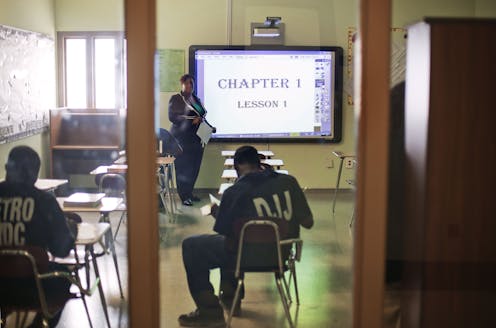Ending sexual assault in youth detention centers
- Written by Eileen M. Ahlin, Assistant Professor, Criminal Justice, Pennsylvania State University

Rampant violence and civil rights abuses in juvenile prisons are prompting calls to shut them down[1].
In the wake of scandals in 2017 in Texas[2] and Florida[3] where correctional officers were accused of sexually assaulting youth in custody, the issue has drawn public attention. First-hand accounts[4] tell us that attacks of inmates by other inmates are also frequent occurrences, though they are notably absent from the news.
According to self-reported data collected by the government, about 10 percent of youth in juvenile detention facilities have been sexually assaulted[5] by other youths or staff.
My recent research[6] shows that youth in juvenile detention facilities are at risk of sexual assault for different reasons than adult inmates. Policies and practices should recognize these differences.
Data on assault
At the turn of the 21st century, a Human Rights Watch report[7] detailed the extent of the prison rape problem. Soon after, in 2003, Congress passed the Prison Rape Elimination Act[8]. However, 15 years have passed, and the rates of sexual victimization in youth detention facilities, jails and prisons remain high[9], particularly among juveniles[10] compared to adults.
The data collection mandated by the 2003 law and spearheaded by the Bureau of Justice Statistics has helped elevate the conversation about prison rape to the national level. However, adults remain the primary focus.
Historically, scholars have mostly used prison data on sexual assault from adult men, and more recently adult women. As a result, most of what we know about sexual assault in correctional facilities is about adult male inmates.
Part of what makes it difficult to gather data on juveniles in custody is that they are considered a vulnerable research population both because of their age and because they are incarcerated[11]. This makes them less able to defend themselves from exploitation and coercion than adults in a free society. Researchers often must obtain youth assent, parental consent and institutional approval in order to collect information.
The lack of data is problematic. As my research and that of others shows, we cannot rely on the body of work among adults to develop measures for protecting youth.
Violence against youth versus adults
I obtained approval from the Department of Justice to access the 2012 National Survey on Youth in Custody data to determine risk factors of sexual victimization among juveniles. I then compared my findings to research conducted by other scholars who collected sexual victimization risk data among adults in prisons.
For example, adults who are “green[12],” or new to prison[13], are more likely to be victimized behind bars. But my research shows that the amount of time spent in a detention facility does not affect risk of sexual assault among youth. It is possible that “being green” is normal among youth in custody. Youth may have spent a similar length of time in custody compared to others in their facility.
Gang affiliation[14] often protects adults from sexual assault by other inmates. By contrast, gang membership in a juvenile detention facility increases a young person’s chance of being sexually assaulted by a staff member. Such violence by staff against youth could be preemptive. In adult jails and prisons, gang members are more likely to attack correctional officers[15]. Staff in youth facilities may lack sufficient training[16] for deescalating situations and may strike first for fear of their safety.
Adult inmates who have a slight physical stature[17] are more likely to be victimized. Height and weight are not risk factors among youth in custody. We would expect youth who have smaller body proportions[18] to be more susceptible to victimization. It is interesting that this is not the case because youth develop at different rates and youth of varying builds are placed in the same facility providing opportunity for victimization.
At the same time, there are some similarities in risk among juveniles and adults. Youth and adults are at higher risk of sexual abuse while detained or incarcerated, if they have previously been sexually victimized in a facility or in the community prior to lock-up. People who have been victimized in the past are more likely to be revictimized[19]. They may become priority targets and may be more vulnerable to attack because of trauma and fear of reporting[20] that can prevent help-seeking.
Also, members of the LGBTQ[21] community are prone to sexual abuse in correctional facilities, regardless of age because of prejudice or discrimination.
When differences in supervision and rehabilitation needs between youths and adults were identified, the first juvenile court was created in 1899 in Cook County, Illinois[22]. The same distinctions that led to a separate justice system for youth such as age and vulnerability can also explain differences in preventing sexual assault in correctional facilities.
The juvenile justice system is a model for all criminal justice institutions when dealing with youth. The majority of youth are processed through a different correctional system than adults. An evaluation of risk, independent from adults, could help shape our responses to sexual assault victimization among youth in custody.
References
- ^ calls to shut them down (www.washingtonpost.com)
- ^ Texas (www.dallasnews.com)
- ^ Florida (www.miamiherald.com)
- ^ First-hand accounts (tjparsell.com)
- ^ have been sexually assaulted (www.bjs.gov)
- ^ recent research (journals.sagepub.com)
- ^ Human Rights Watch report (www.hrw.org)
- ^ Prison Rape Elimination Act (www.bjs.gov)
- ^ remain high (www.bjs.gov)
- ^ among juveniles (www.bjs.gov)
- ^ both because of their age and because they are incarcerated (www.ncbi.nlm.nih.gov)
- ^ green (journals.sagepub.com)
- ^ new to prison (onlinelibrary.wiley.com)
- ^ Gang affiliation (www.rienner.com)
- ^ attack correctional officers (www.sciencedirect.com)
- ^ lack sufficient training (host.madison.com)
- ^ slight physical stature (scholarlycommons.law.northwestern.edu)
- ^ smaller body proportions (adc.bmj.com)
- ^ revictimized (journals.sagepub.com)
- ^ trauma and fear of reporting (www.girlsglobe.org)
- ^ LGBTQ (transequality.org)
- ^ 1899 in Cook County, Illinois (scholarship.law.umn.edu)
Authors: Eileen M. Ahlin, Assistant Professor, Criminal Justice, Pennsylvania State University
Read more http://theconversation.com/ending-sexual-assault-in-youth-detention-centers-92336


